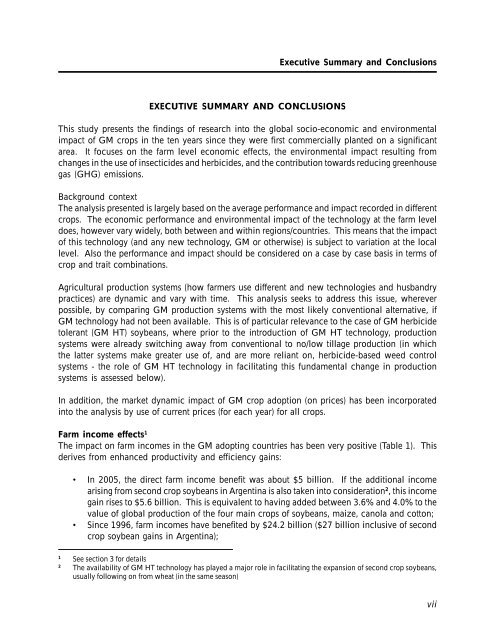GM Crops: The First Ten Years - International Service for the ...
GM Crops: The First Ten Years - International Service for the ...
GM Crops: The First Ten Years - International Service for the ...
Create successful ePaper yourself
Turn your PDF publications into a flip-book with our unique Google optimized e-Paper software.
EXECUTIVE SUMMARY AND CONCLUSIONS<br />
Executive Summary and Conclusions<br />
This study presents <strong>the</strong> findings of research into <strong>the</strong> global socio-economic and environmental<br />
impact of <strong>GM</strong> crops in <strong>the</strong> ten years since <strong>the</strong>y were first commercially planted on a significant<br />
area. It focuses on <strong>the</strong> farm level economic effects, <strong>the</strong> environmental impact resulting from<br />
changes in <strong>the</strong> use of insecticides and herbicides, and <strong>the</strong> contribution towards reducing greenhouse<br />
gas (GHG) emissions.<br />
Background context<br />
<strong>The</strong> analysis presented is largely based on <strong>the</strong> average per<strong>for</strong>mance and impact recorded in different<br />
crops. <strong>The</strong> economic per<strong>for</strong>mance and environmental impact of <strong>the</strong> technology at <strong>the</strong> farm level<br />
does, however vary widely, both between and within regions/countries. This means that <strong>the</strong> impact<br />
of this technology (and any new technology, <strong>GM</strong> or o<strong>the</strong>rwise) is subject to variation at <strong>the</strong> local<br />
level. Also <strong>the</strong> per<strong>for</strong>mance and impact should be considered on a case by case basis in terms of<br />
crop and trait combinations.<br />
Agricultural production systems (how farmers use different and new technologies and husbandry<br />
practices) are dynamic and vary with time. This analysis seeks to address this issue, wherever<br />
possible, by comparing <strong>GM</strong> production systems with <strong>the</strong> most likely conventional alternative, if<br />
<strong>GM</strong> technology had not been available. This is of particular relevance to <strong>the</strong> case of <strong>GM</strong> herbicide<br />
tolerant (<strong>GM</strong> HT) soybeans, where prior to <strong>the</strong> introduction of <strong>GM</strong> HT technology, production<br />
systems were already switching away from conventional to no/low tillage production (in which<br />
<strong>the</strong> latter systems make greater use of, and are more reliant on, herbicide-based weed control<br />
systems - <strong>the</strong> role of <strong>GM</strong> HT technology in facilitating this fundamental change in production<br />
systems is assessed below).<br />
In addition, <strong>the</strong> market dynamic impact of <strong>GM</strong> crop adoption (on prices) has been incorporated<br />
into <strong>the</strong> analysis by use of current prices (<strong>for</strong> each year) <strong>for</strong> all crops.<br />
Farm income effects 1<br />
<strong>The</strong> impact on farm incomes in <strong>the</strong> <strong>GM</strong> adopting countries has been very positive (Table 1). This<br />
derives from enhanced productivity and efficiency gains:<br />
• In 2005, <strong>the</strong> direct farm income benefit was about $5 billion. If <strong>the</strong> additional income<br />
arising from second crop soybeans in Argentina is also taken into consideration 2 , this income<br />
gain rises to $5.6 billion. This is equivalent to having added between 3.6% and 4.0% to <strong>the</strong><br />
value of global production of <strong>the</strong> four main crops of soybeans, maize, canola and cotton;<br />
• Since 1996, farm incomes have benefited by $24.2 billion ($27 billion inclusive of second<br />
crop soybean gains in Argentina);<br />
1 See section 3 <strong>for</strong> details<br />
2 <strong>The</strong> availability of <strong>GM</strong> HT technology has played a major role in facilitating <strong>the</strong> expansion of second crop soybeans,<br />
usually following on from wheat (in <strong>the</strong> same season)<br />
vii
















